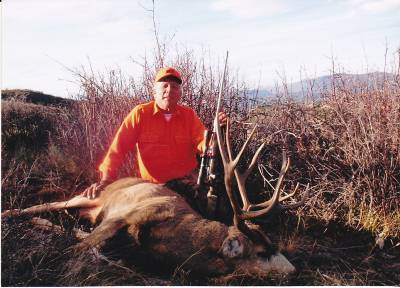
If you want to kill a big mule deer, you can’t just rely on one or two tactics to get the job done. Mule deer live in variety of habitats and are hunted in different seasons and situations. A hunter has to be able to pull from a diverse background of experience to meet the challenges presented on any mule deer hunt. If you can’t adapt, you will be frustrated far more than you will be successful.
As I wrote in “Moving in Deer Country” Part I and Part II, big mature bucks are so alert, that simply bumping into one and getting off a killing shot is an exercise in futility. You must overcome their sense of sight, smell, and feeling (bucks can feel vibrations through the ground). I prefer hunting on my feet—moving through cover, stopping to glass, tracking, and just hunting actively— but by the very nature of hunting that way, I’m likely spooking bucks. Sometimes the only way to kill a big buck is to ambush him as he travels between cover and feed.
Old bucks move very deliberately and seldom walk into danger. However, a stationary hunter with the wind in his favor is almost impossible to detect by even the keenest buck. For years, I noticed that if I sat and glassed quietly for a few hours, often when I’d stand and walk away, I’d spook deer that had moved into range. Inadvertently, I was learning the technique of waiting for the deer to come to me.
I was fortunate enough to hunt some Colorado deer country with my friend Kirt Darner about 10 years ago (pictured above). While Kirt has had his legal problems, some his own fault, he is still one of the best mule deer hunters alive today. I’d hunted the area three seasons before he accompanied me so I was very familiar with it. I’d typically hike or ride horseback from glassing point to glassing point and watch for bucks I could stalk. The area is very thick so I couldn’t always stalk the bucks (including a few giants) I’d spotted.
Kirt was only in camp two days when I noticed he was hunting completely different than me. While he glassed plenty, he was also not afraid to plop his rear end down in an area with ample sign and sit quietly for a few hours. He didn’t care if he could only see 50 yards or 150 yards—he knew if he was in a likely area, the deer would close the gap. On only his third day in the unit, he killed a beautiful 27″ 180-class buck (lab-aged at seven years old). Kirt ambushed him one morning while sitting and watching some brushy cover when the buck followed a hot doe within range. Kirt simply raised his rifle and busted him.
For those of you that followed my Live Colorado Muzzleloader Hunt last fall, where I killed a 190″ gross typical, you’ll remember that it was by ambush that I took him. The video I shot in the days before I killed him showed how thick that terrain was. I’d seen bucks at first light heading for the cover but knew they could be anywhere once they bedded. Still-hunting was an option, but with so much cover, it would be tough to narrow down where they might bed. I opted to wait them out between bedding and feeding areas. It took a few days, but they eventually appeared within range as they drifted out of the junipers. Even though I’d been silent, the buck saw me raise my muzzleloader from 120 yards. He almost spooked before I got the shot off, again testifying how alert older bucks are (he later lab-aged at seven years). Had I not been ambush hunting, that buck would have never fallen to a muzzleloader.
When to ambush
- The bucks are getting into heavy cover before you can make a stalk
- The conditions are so noisy that you can’t stalk (including crunchy snow)
- There are game trails in the area with fresh buck tracks
- Others are hunting sloppily around you.
- Dry areas with a secluded small water source with buck tracks
In all of these scenarios, simply waiting and watching might do the trick. It doesn’t require an Electrical Engineering degree to be successful. Just find an area where deer are moving in or to cover, get the wind in your favor, dress warm enough that you can sit a spell, and stay alert. It seems the first and last few hours of the day are best, but bucks can move mid-day, too. Every situation will be different. Be patient and encourage yourself with this thought:
A motionless hunter with the wind in his favor is nearly undetectable to a big mule deer.
I took this 190″ gross buck by ambush hunting some heavy cover with a muzzleloader. He later lab-aged at seven years old.
If you’d like to help the Rok Blog, please “Share” this blog post with friends and family from Rokslide’s Facebook page .
Stay tuned, next week the Rok Blog is hosting our biggest single giveaway yet. You gear freaks will be pleased. Make sure you subscribe at top right under Fitness/Other at “Subscribe to blog” so you don’t miss this next post.




















Nice write up and awesome mule deer Robby. I’m always trying to sharpen my skills on mule deer tactics. Thanks
You bet, Brady. And the best way to sharpen your tactics is just go deer hunting! How’s that for a win-win?
Nice write up dobby thanks
Comments are closed.